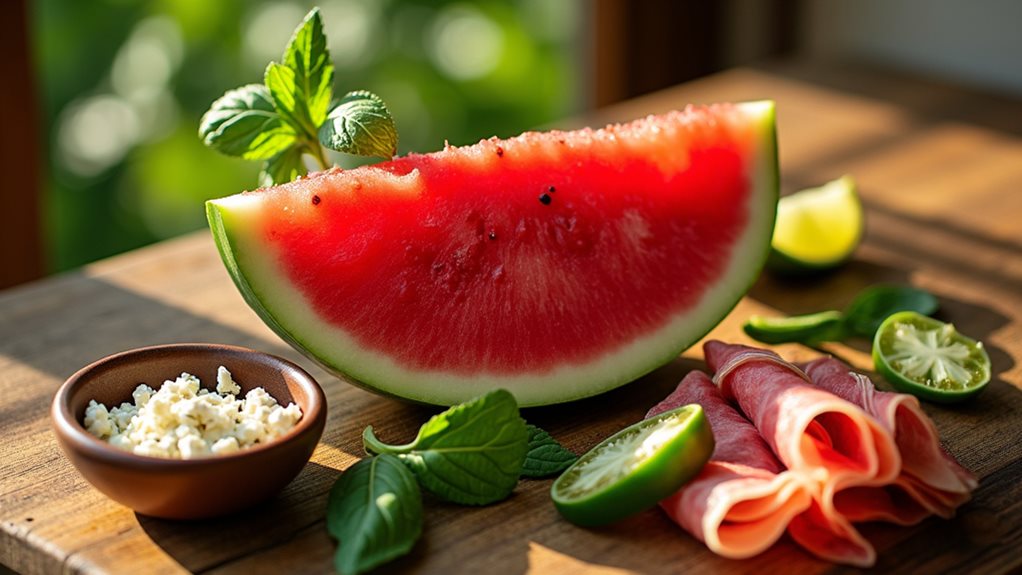Yuzu's complex citrus profile pairs beautifully with seafood, especially salmon and scallops, while enhancing poultry when used in marinades. You'll find it complements fruits like pear, coconut, and mango in desserts, and balances spicy ingredients like chili peppers in yuzu kosho. For herbal companions, try basil, mint, or lavender. In beverages, combine with sparkling water, matcha, or mint for invigorating drinks. Beyond Japanese cuisine, yuzu adds brightness to Mediterranean dishes and Mexican salsas with its distinctive flavor profile.
Understanding the Unique Citrus Profile of Yuzu

Yuzu, a treasure of East Asian cuisine, offers a flavor profile unlike any other citrus fruit you'll encounter. Native to East Asia, this small, rough-skinned fruit combines the tartness of grapefruit, the brightness of lemon, and the aromatic qualities of mandarin, creating a complex flavor that's become increasingly sought-after by innovative chefs worldwide.
Throughout its rich yuzu history, this distinctive citrus has evolved from a regional ingredient to a global culinary star. Unlike common lemons or limes, yuzu delivers floral and herbaceous notes that transform dishes with minimal effort. The fruit's initial tanginess transitions to a nuanced sweetness that adds depth to various culinary applications. The fruit's intense aroma makes it an exceptional choice for both sweet and savory applications, from marinades to cocktails.
The yuzu health benefits are equally impressive—packed with vitamin C and antioxidants, it supports immune function while adding exceptional flavor to your culinary creations.
Enhancing Sweet Dishes With Yuzu and Fruit Combinations
When exploring the sweet side of culinary innovation, you'll discover that yuzu elevates fruit-based desserts to extraordinary heights. This Japanese citrus creates magical sweet yuzu enhancements when paired strategically with complementary fruits.
Try combining yuzu with pears or apricots, where the fruit's natural sweetness balances yuzu's distinctive tartness. For tropical adventures, blend yuzu with coconut, passion fruit, or mango to create exotic flavor profiles that surprise and delight the palate.
You'll find that yuzu fruit combinations work particularly well in frozen desserts like sorbets or ice creams, where the citrus notes can fully develop. The high vitamin C content in yuzu not only adds nutritional benefits but also brightens the overall flavor profile of these desserts.
Don't hesitate to experiment with unexpected pairings like yuzu and white chocolate or yuzu and black sesame for sophisticated desserts that showcase your culinary creativity. Yuzu's unique flavor, described as a blend of lemon, grapefruit, and mandarin, creates depth and complexity in sweet applications that few other citrus fruits can achieve.
Yuzu in Japanese Cuisine: Traditional Pairings and Preparations

Moving from sweet creations to authentic traditions, let's explore yuzu's ceremonial place in Japanese cuisine. This citrus fruit shines in classic preparations like ponzu sauce, where its tart juice combines with soy, rice vinegar, and dashi to create a versatile dipping sauce for seafood or vegetables.
You'll find yuzu kosho, a spicy-citrus condiment, adding dimension to soups and grilled proteins, while its aromatic zest elevates sashimi presentations. One popular dish combines edamame with yuzu ponzu, creating a harmonious balance of sweetness and tanginess.
Despite yuzu cultivation challenges, including slow-growing thorny trees and limited geographical adaptability, chefs prize its distinctive flavor profile that blends mandarin, lemon, and floral notes.
The yuzu health benefits, including high vitamin C content, complement its culinary applications.
When pairing yuzu with proteins, remember it works beautifully with seafood, especially salmon and scallops, enhancing their natural flavors without overwhelming them.
Although not particularly sweet, yuzu delivers a refreshing flavor that makes it ideal for both savory and sweet applications.
The Art of Balancing Yuzu With Spicy Ingredients
The delicate art of pairing yuzu with spicy ingredients creates a symphony of flavors that dance between bright citrus notes and fiery heat.
The culinary magic happens when yuzu's bright complexity meets the bold character of heat-forward ingredients.
You'll discover that yuzu's complex profile—combining grapefruit, lime, and mandarin with floral undertones—ideally tempers intense spices while enhancing their character.
For creating spicy condiments, consider yuzu kosho, a traditional paste blending yuzu zest with chili peppers and salt. It's available in both red and green varieties, offering versatile applications for grilled meats and vegetables. Green yuzu kosho provides a spicier, fresh flavor compared to its red counterpart, making it an excellent choice when you want more heat impact. For a convenient option, products like the Spicy Yuzu Miso Topping & Spread offer a ready-made solution that combines the refreshing citrus notes of yuzu with the umami richness of miso.
When seeking ideal heat balance, combine yuzu with ginger for warmth, wasabi for sharp intensity, or cayenne for steady heat. The citrus's natural acidity helps mitigate burning sensations while contributing aromatic complexity that prevents spicy elements from overwhelming your dish.
Botanical Companions: Herbs That Elevate Yuzu's Flavor

Yuzu's vibrant citrus profile finds its perfect complement in the botanical world, where herbs can elevate and transform its distinctive flavor into complex culinary experiences. Your herb selection matters greatly—lavender creates a calming yet zesty combination, while basil brings sweet, peppery notes that balance yuzu's tartness.
For revitalizing beverages, pair mint with yuzu for an invigorating effect. Achieve perfect flavor balance by considering seasonal availability of herbs. For a bright finishing touch, drizzle yuzu oil over herb-infused dishes just before serving to preserve aroma intensity. Try infusing yuzu juice with chamomile for a soothing tea, or combine yuzu zest with fresh rosemary to enhance marinades. Enthusiasts also recommend pairing yuzu with peppermint tea for a uniquely refreshing flavor profile that highlights yuzu's zesty characteristics.
You'll find that herbs not only complement yuzu's taste but also contribute nutritional benefits—many herb-yuzu pairings offer antioxidant properties and potential mood-enhancing effects. Experiment with yuzu-basil dipping sauces or mint-yuzu salad dressings for innovative culinary applications.
Crafting Refreshing Yuzu Beverages for Every Season
As seasons shift throughout the year, so too can your yuzu beverage repertoire, offering unique drinking experiences that highlight this distinctive citrus fruit's versatility.
Summer calls for light yuzu lemonades and spritzers, while autumn invites warming yuzu cider and ginger beer combinations that complement the season's spicy notes.
Winter's chill pairs beautifully with yuzu hot chocolate or cranberry jellies for seasonal yuzu cocktails, bringing brightness to darker days.
When spring arrives, revitalize your senses with yuzu mint refreshers or cucumber blends.
Year-round yuzu beverage trends include matcha pairings and simple syrups that work across seasons.
You'll find yuzu's adaptability impressive—whether infused in hot teas during colder months or mixed with sparkling water when temperatures rise, this Japanese citrus transforms ordinary drinks into extraordinary experiences.
Savory Applications: Yuzu in Main Courses and Marinades
Moving beyond beverages, savory dishes showcase yuzu's incredible versatility in the culinary world. This Japanese citrus transforms ordinary proteins into extraordinary meals through innovative yuzu applications.
Try marinating chicken in yuzu juice with herbs for a perfect sweet-savory balance, or combine it with soy sauce for a umami-rich glaze ideal for pork and poultry.
You'll find yuzu particularly stunning in Asian-inspired dishes like miso soup enhanced with yuzu kosho or udon noodles brightened with its distinctive tang.
For seafood enthusiasts, pan-seared scallops with yuzu butter or yuzu-glazed salmon deliver sophisticated flavor profiles with minimal effort.
Even simple vegetables receive gourmet treatment—roasted vegetables, grilled asparagus, and steamed broccoli all benefit from yuzu's aromatic complexity when incorporated into dressings, butters, and glazes.
Yuzu Desserts: Beyond the Expected Citrus Sweets
When exploring the sweet side of this distinctive Japanese citrus, you'll discover that yuzu desserts transcend ordinary lemon-based treats, offering a complex flavor profile that's both familiar and exotic. The fruit's unique blend of grapefruit, lime, and mandarin notes creates dessert innovations that surprise and delight.
For sophisticated yuzu applications, pair it with complementary ingredients like honey to soften its tartness, or white chocolate to create luxurious depth.
Try a yuzu panna cotta for an Italian-Japanese fusion, or transform ordinary vanilla ice cream with yuzu jam. The fruit also shines in textural contrasts—think airy meringue atop creamy yuzu tarts or crumbly shortcrust beneath tangy curd.
Even if fresh yuzu isn't available, its essence and juice are readily accessible for your culinary experiments.
Global Fusion: Incorporating Yuzu in Non-Asian Cuisines
While yuzu shines brilliantly in desserts, this versatile Japanese citrus doesn't need to stay confined to sweet endings or traditional Asian applications.
You'll find exciting creative yuzu applications emerging in Mediterranean, Latin American, and European cooking traditions.
Try incorporating yuzu juice in a classic French beurre blanc for fish, or blend it into Mexican salsas for a unique citrus dimension.
Its complex flavor profile—combining lemon, orange, and grapefruit with herbal notes—works surprisingly well with Italian risottos or Spanish gazpachos.
Global yuzu trends show chefs pairing it with ingredients like olive oil, manchego cheese, and even chorizo.
The fruit's ability to enhance umami makes it perfect for non-Asian marinades and sauces, while its brightness cuts through rich dishes from any culinary tradition.
Preserving Yuzu: Techniques for Capturing Its Essence Year-Round
Yuzu's signature brightness presents a seasonal challenge for chefs and home cooks alike, as this coveted citrus fruit has a notoriously short harvesting period.
Fortunately, several methods exist to preserve yuzu zest and juice, extending your access to this distinctive flavor throughout the year.
For ideal flavor preservation, freeze yuzu zest by flash-freezing julienned strips on parchment-lined baking sheets for 30-60 minutes before transferring to freezer bags.
You'll appreciate that it can be used directly from frozen without thawing.
Alternatively, create yuzu kosho by combining yuzu zest with chilis and salt, or mix the peel with sugar for a sweet condiment.
Juice can be frozen in ice cube trays, refrigerated for up to three months, or preserved with sugar or salt for extended storage.
Frequently Asked Questions
Is Yuzu Oil a Suitable Substitute for Fresh Yuzu Juice?
Yes, you can substitute yuzu oil for fresh yuzu juice, but it's more concentrated. You'll need to adjust quantities carefully—start with less than called for, as the oil delivers intense flavor without the juice's acidity.
Can Yuzu Be Paired Successfully With Dairy-Based Ingredients?
Yes, you'll find yuzu pairs beautifully with dairy ingredients! Its citrus zing cuts through richness in creamy sauces and transforms conventional desserts. Try yuzu desserts like panna cotta or infuse it into ice cream for innovative flavor combinations.
How Does Altitude Affect the Flavor Profile of Yuzu?
Higher, cooler, more intense—you'll notice how altitude transforms yuzu cultivation. At elevated heights, you're getting concentrated flavors as these citrus fruits develop slower, accumulating more complex terpenes and volatile compounds for a bolder profile.
Are There Any Notable Allergic Reactions to Yuzu?
You should know yuzu allergies can range from mild skin reactions to rare anaphylaxis. If you have citrus sensitivity, be cautious—yuzu contains limonene that may cause contact dermatitis or cross-react with pollen allergies.
What Wine Varieties Best Complement Dishes Containing Yuzu?
Like a citrus symphony, you'll find Chenin Blanc, Vinho Verde, and dry Riesling perfectly complement yuzu dishes. For yuzu desserts, try Muscat, while yuzu cocktails shine with sparkling wines that enhance their innovative flavor profiles.
Final Thoughts
You've now explored yuzu's versatility across cuisines, from traditional Japanese pairings to global fusion experiments. Like a skilled conductor bringing together different instruments in perfect harmony, you'll create symphonies of flavor when you pair yuzu's bright notes with complementary ingredients. Whether you're incorporating yuzu in savory marinades or delicate desserts, don't hesitate to experiment—the distinctive citrus profile will continue to inspire your culinary creativity for years to come.















